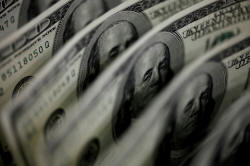Dollar hits 3-month high, eyes on payrolls
 Send a link to a friend
Send a link to a friend
 [July 01, 2021] By
Ritvik Carvalho [July 01, 2021] By
Ritvik Carvalho
LONDON (Reuters) - The dollar index hit
3-month highs on Thursday, ahead of a U.S. jobs report that could offer
clues on when the Federal Reserve will start to pare back stimulus.
The U.S. currency rose as high as 111.50 yen for the first time since
March 25, 2020, up 0.3% on the day.
The dollar index, which measures the greenback against six counterparts,
rose to as much as 92.547 in early European deals, its highest since
April 6.
The index posted its best month since November 2016 in June, driven by
the Federal Open Market Committee's (FOMC) surprise hawkish shift in the
middle of that month, when policymakers signalled two interest rate
hikes by the end of 2023.
"The failure of dollar sellers to re-emerge in the past couple of weeks
has undermined the confidence of long standing dollar bears," said Jane
Foley, head of FX strategy at Rabobank.
"The debate about whether or not the Fed could hike rates as soon as
2022 was unleashed by the June 16 FOMC and, as long as U.S. data remain
broadly supportive, we expect that this risk will keep the dollar better
bid."

Traders are looking to Friday's U.S. nonfarm payrolls report for
confirmation of that outlook, with economists polled by Reuters
expecting a gain of 700,000 jobs last month, compared with 559,000 in
May, and an unemployment rate of 5.7% versus 5.8% in the previous month.
The greenback extended gains on Wednesday after data showed U.S. private
payrolls increased by a greater-than-expected 692,000 jobs in June.
"The end of 2Q21 was accompanied by additional dollar gains against all
FX majors as stronger than expected U.S. ADP data, optimistic comments
from Atlanta Fed President Bostic and lack of risk appetite in most
equity markets helped the greenback yesterday," said Roberto Cobo
Garcia, FX strategist at BBVA.
"The move has been prolonged today despite the solid PMI readings in the
EMU and the risk on mood in commodities and equity markets."
[to top of second column] |

A picture illustration shows U.S. 100-dollar bank notes taken in
Tokyo August 2, 2011. REUTERS/Yuriko Nakao/File Photo

The euro edged down to $1.1851 after dipping as low as $1.1837 on Thursday for
the first time since April 6, before recovering to trade flat after euro zone
purchasing manager's indexes (PMIs) came in higher than expected.
Elsewhere in Europe, Sweden's crown dipped, losing 0.3% against the dollar to
trade at 8.57 crowns per dollar and 0.2% against the euro to 10.16 crowns per
euro.
The Swedish central bank kept policy unchanged on Thursday.
The country's politicians were still struggling to form a new government
following the resignation of Social Democrat Prime Minister Stefan Lofven after
losing a no confidence vote last week.
The Aussie dollar, seen as a proxy for risk appetite, slid 0.2% to $0.7476,
hitting that level for the first time since Dec. 21, with Australia's major
centres of Sydney, Brisbane, Perth and Darwin all under lockdown.
The Reserve Bank of Australia will meet next Tuesday to decide on policy, and
officials have already flagged it will announce its decisions on its three-year
yield target as well as its broader quantitative easing programme, which is set
to end in September.
RBA Governor Philip Lowe will also hold a news conference afterwards, in a break
from recent procedure.
Sterling slipped 0.5% to $1.3765, to hit a fresh two-month low against the
dollar.
(Reporting by Ritvik Carvalho; additional reporting by Kevin Buckland in Tokyo;
editing by Barbara Lewis, Simon Cameron-Moore and Chizu Nomiyama)

[© 2021 Thomson Reuters. All rights
reserved.] Copyright 2021 Reuters. All rights reserved. This material may not be published,
broadcast, rewritten or redistributed.
Thompson Reuters is solely responsible for this content. |